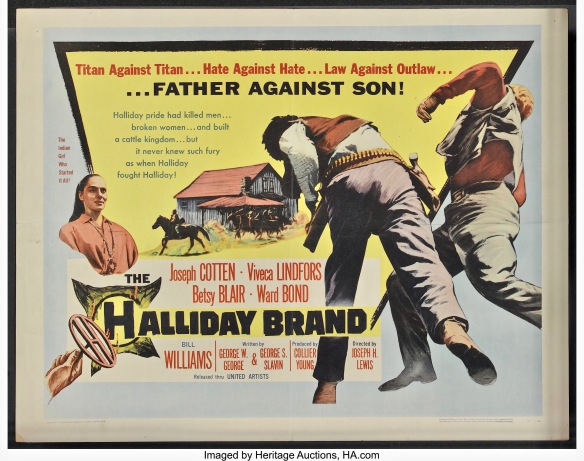If you are a post-WW2 baby boomer, you are probably familiar with the term ‘the Red Scare,’ which refers to a time in the late forties-early fifties when anti-communist sentiment in the U.S. was at its height (The “red” refers to the color of the Soviet flag). This Cold War era paranoia was not just reflected in American politics and daily news stories but he popular culture as well, especially movies. Some of the more famous examples are the Howard Hughes’ produced noir I Married a Communist (1949 aka The Woman on Pier 13), the 1951 tabloid-style expose I Was a Communist for the F.B.I. and John Wayne as an undercover commie hunter in Big Jim McLain (1952). Yet, of all the cinematic depictions of Communist infiltration in America, few are as blatant or as infamous as My Son John (1952), which was released when the House Committee on Un-American Activities (HUAC) was at the height of its power and Senator Joseph McCarthy was still fanning the flames of a political witch hunt that had already taken its toll on the entertainment industry.
Tag Archives: HUAC
When Best Laid Plans Go Awry
 On first impressions The Big Caper (1957) may look like just another grade B bank heist thriller but don’t be fooled. This 1957 independent pickup by United Artists is a genuine loose canon and highly peculiar within its own specialized genre. In the best heist thrillers (Rififi, The Asphalt Jungle), the robbery is usually ingeniously planned and executed but when it goes awry, it’s usually due to festering hatred among the instigators (Odds Against Tomorrow) or bad luck (Plunder Road). In The Big Caper, the glaring flaw is the organizer who appears to be a shrewd and cautious businessman until you see the wacko team he assembles for the job. And he might be the biggest nutcase in the lot. It’s not a comedy, but it should be, and you may very well find yourself laughing uncontrollably at times. Continue reading
On first impressions The Big Caper (1957) may look like just another grade B bank heist thriller but don’t be fooled. This 1957 independent pickup by United Artists is a genuine loose canon and highly peculiar within its own specialized genre. In the best heist thrillers (Rififi, The Asphalt Jungle), the robbery is usually ingeniously planned and executed but when it goes awry, it’s usually due to festering hatred among the instigators (Odds Against Tomorrow) or bad luck (Plunder Road). In The Big Caper, the glaring flaw is the organizer who appears to be a shrewd and cautious businessman until you see the wacko team he assembles for the job. And he might be the biggest nutcase in the lot. It’s not a comedy, but it should be, and you may very well find yourself laughing uncontrollably at times. Continue reading
A Western Greek Tragedy
 By the 1950s, the popularity of the Western genre was in decline and Hollywood studios tried to revitalize the once box office proof formula by trying everything from Technicolor and Cinemascope visual enhancements to hybrid novelties such as 1954’s Red Garters (a musical with stylized sets) and 1959’s Curse of the Undead (featuring a vampire gunslinger) to topical approaches that reflected a growing interest in psychology such as The Furies [1950] and High Noon [1952]. Into the latter category falls The Halliday Brand [1957], one of the more intense but least well known of the adult Westerns being produced in that era. Continue reading
By the 1950s, the popularity of the Western genre was in decline and Hollywood studios tried to revitalize the once box office proof formula by trying everything from Technicolor and Cinemascope visual enhancements to hybrid novelties such as 1954’s Red Garters (a musical with stylized sets) and 1959’s Curse of the Undead (featuring a vampire gunslinger) to topical approaches that reflected a growing interest in psychology such as The Furies [1950] and High Noon [1952]. Into the latter category falls The Halliday Brand [1957], one of the more intense but least well known of the adult Westerns being produced in that era. Continue reading
Norman Lloyd: Hollywood’s Long Distance Runner, Part 1
On November 8, 2017 Norman Lloyd will be 203 and he shows no signs of slowing down. In recent years, he has become the go-to historian for the American film industry’s golden era due to his friendship and working relationships with such cinema legends as Charlie Chaplin, Jean Renoir, Orson Welles, Alfred Hitchcock, John Garfield, Bernard Herrmann, John Houseman, Joseph Losey and others. Lloyd also continues to take acting roles (he has a nice cameo in the 2015 Judd Apatow comedy Trainwreck starring Amy Schumer) and appear as an interviewee in documentaries such as Marsha Hunt’s Sweet Adversity (2015) and Broadway: Beyond the Golden Age, which is currently in post-production.
*This is a revised and updated version of the original interview which was recorded in March 2010 just prior to Lloyd’s appearance at the first Turner Classic Movies Classic Film Festival. Continue reading



